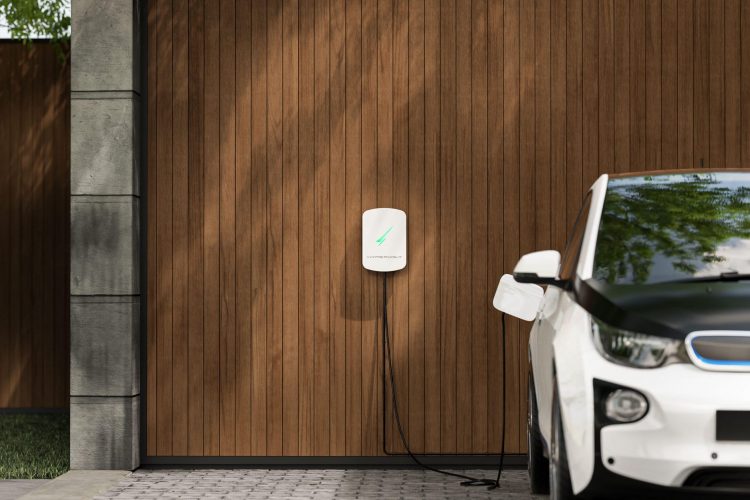
There are many charging solutions for electric cars to fit a variety of scenarios and lifestyles. By far the most common option is at-home charging with around 60% of EV drivers using this solution. However, this often requires the installation of a home charger and the use of off-street parking. This may not be an option if you live in rented accommodation, flats or terraced housing. That said, this should not be a deterrent for prospective EV owners and there are many charging alternatives that can be utilised instead of off-street home charging.
Home Charging without a Driveway
Even if you do not have an off-street area to park your car, you can still make use of your home’s power source by connecting your EV while it is parked on the street outside your home. You will be able to run a charging cable across the pavement that separates the property boundary from the parking spot. This can be difficult because the cable is laying across public property and can create a safety risk for others. You will need to ask for permission from your local authority before you go ahead. Moreover, there is increased risk of theft or damage to the cable if not secured correctly.
If the distance between your home and vehicle is longer than your existing cable, you may need to invest in a longer cable, or a cable extension for outdoor use. You should also try to lay the cable as flat as possible. The best solution may be a cable protector or pavement cable channel which allows the cable to be covered and protected while in place. These usually have brightly coloured taping to make them visible and ensure that they pose minimal trip risk.
This option can also be used without installing an EV charger at home. You can take advantage of portable chargers with 3 pin connections that fit into a regular electrical socket, known as “granny chargers”. However, they tend to be less efficient than other cables and should be used with caution. It is recommended that these only be used on homes with modern electrical wiring, or after an electrician has inspected the home if you plan on long-term use.

On-street Public Chargers
There has been wave of investment in EV infrastructure in the UK in recent years and one area of focus is increasing the number of on-street public chargers. These can come in two forms: the more common EV charging bays or kerbside chargers. Charging bays can be a useful solution for EV drivers when out and about. They are often fast chargers so will charge your car in a few hours and will likely be free of charge. However, these bays are more common in city or town centre locations and are unlikely to be near residential areas.
Alternatively, companies like Connected Kerb have developed new on-street chargers which blend seamlessly into our environment. Solutions have been created which are attached to lampposts or that are installed flush with the pavement. Integrating these into our streets would allow EV drivers to charge while parked almost anywhere. They also prevent charging from becoming an inconvenience to other road and pavement users by being as aesthetically minimal as possible. While this is relatively new technology, council areas across the UK have already started investing in these charging solutions and they may not be far off in your neighbourhood. If you think this solution would work well for you, you can also submit a request here.
Talk to Your Local Council
Your council is entitled to funds from the On-Street Residential ChargePoint Scheme (ORCS) to subsidise the installation of on-street public charging in areas where home charging is not possible. You can write to your local council here and request that they apply for funding to install charging on your street. They can claim up to 75% of the cost of charge point installation back from the OCRS.

Public Charging
It is worth bearing in mind that many EV users will not need to travel the full range of their EV every time. Therefore, ad hoc public charging to fit into your lifestyle is likely to be a useful option.
Public charging can come in many forms: on-street charging, charging hubs and public car park charging. As we have mentioned above, public charging bays are very common in urban areas, these are the green EV parking spaces in your local town centre. Charging hubs are usually at service stations or park-and-ride destinations. These hubs are becoming more common on major routes, or in commuter towns, and have been a major source of both private and public investment. Finally, car park charging may be in the form of designated EV sections in larger car parks but there are now examples of fully electric car parks in some major UK cities.
Many of these charging solutions are provided by government funding, either partially or fully. However, they are often spearheaded by commercial firms who want to invest in a greener future and encourage business from EV drivers. For example, fast food chain, McDonalds, is installing EV chargers at all drive through sites in the UK.
Whether private or public, the way you use these charge points is similar. Some older chargers require a contactless RFID card, but many now work using free mobile apps. Charging at supermarkets or service stations is often free but some charge a small fee per minute. Rapid chargers are more expensive at around £6 for 30 minutes of charge, the equivalent of around 100 miles range. There are also many apps which can help you plan your journey around charging stations. Some electric vehicles even have these built-in so that it will help you navigate to a charge point when you are running low.
There are around 19,000 devices on the UK public charging network, of which 3,289 are rapid chargers. A regular public charger usually operates on 7 to 12 kW which charges your vehicle in anything from 1 to 6 hours. These are best used when you can stop for an hour or more while your car charges. Most regular chargers do not have charging cables attached but will have a universal connection. This means you will need to keep a cable in your car for charging on the go. Rapid chargers work on a 50kW supply and are usually found at motorway services or near major roads. These allow vehicles to be fully charged in less than an hour. Most rapid chargers have a ‘tethered’ cable so will only be able to charge compatible vehicles with rapid charging capability. This information will be included in the vehicle manual but is also obvious from the appearance of the connection.
We are working closely with local authorities and commercial firms throughout the UK to help install public charging points. We are collaborating with our partners to help deliver on-street charging solutions and larger charging hubs. We hope that increasing the variety of charging solutions will make electric vehicles much more accessible to those who cannot install a home charger. Visit here for more information on commercial installation of public charge points.
In summary, while it may seem like the lack of off-street charging is a barrier to your adoption of electric travel, there are clearly a wide range of alternative charging solutions that you can consider. If you own an EV or are thinking of transitioning to electric and would like to know more, please get in touch. A member of our technical team would be happy to answer any questions that you have.





